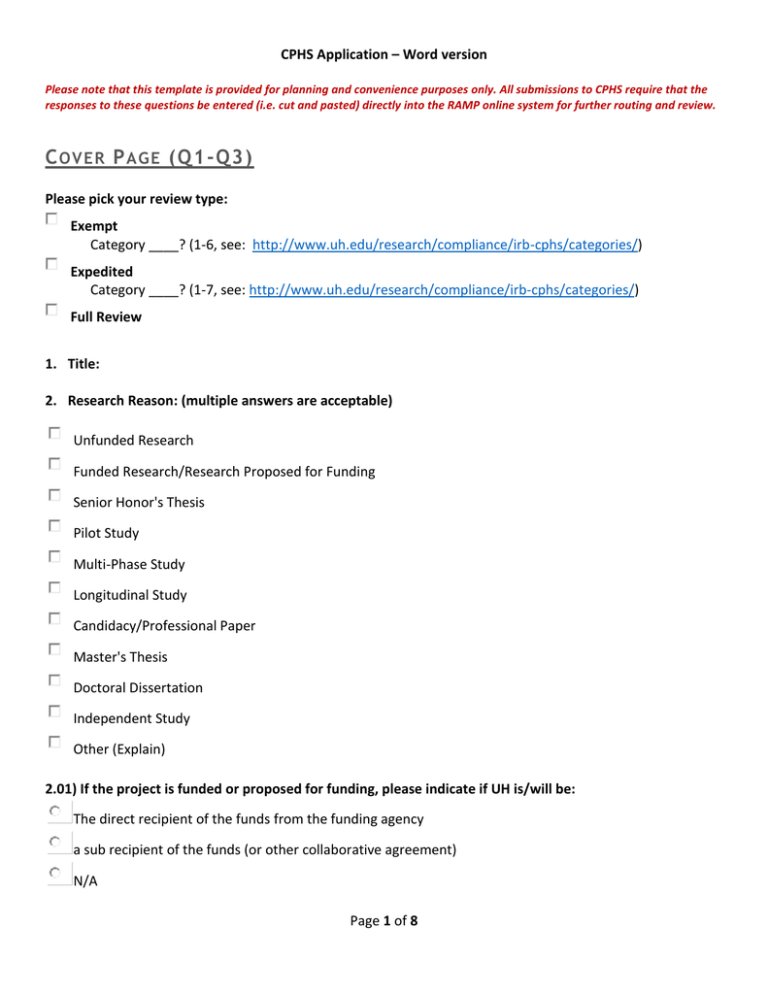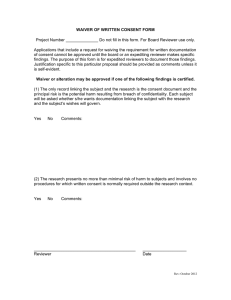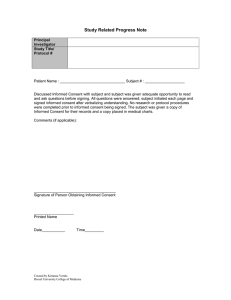CPHS Application – Word version
advertisement

CPHS Application – Word version Please note that this template is provided for planning and convenience purposes only. All submissions to CPHS require that the responses to these questions be entered (i.e. cut and pasted) directly into the RAMP online system for further routing and review. C O VER P AG E (Q1-Q3) Please pick your review type: Exempt Category ____? (1-6, see: http://www.uh.edu/research/compliance/irb-cphs/categories/) Expedited Category ____? (1-7, see: http://www.uh.edu/research/compliance/irb-cphs/categories/) Full Review 1. Title: 2. Research Reason: (multiple answers are acceptable) Unfunded Research Funded Research/Research Proposed for Funding Senior Honor's Thesis Pilot Study Multi-Phase Study Longitudinal Study Candidacy/Professional Paper Master's Thesis Doctoral Dissertation Independent Study Other (Explain) 2.01) If the project is funded or proposed for funding, please indicate if UH is/will be: The direct recipient of the funds from the funding agency a sub recipient of the funds (or other collaborative agreement) N/A Page 1 of 8 3. If this application supports a proposal for funding, provided funded research project ID. (Proposal Abstract or Statement of Work must be uploaded with this application). Key Personnel Add/Delete Personnel Name Personnel Type Is External? Is Student? Faculty Sponsor (Note: RAMP allows search and dropdown functions here. Please ensure that all individuals involved in the research (including recruitment, consent, study procedures, analysis of identifiable data, etc.) are included and have completed CITI training. Student investigators require a faculty sponsor.) R ESE AR C H PR O J ECT R EVI EW S U MM AR Y (Q4-Q10 ): 4. State the specific research hypotheses or questions to be addressed in this study: 5. What is the importance/significance of the knowledge that may result? 6. Type of Subject Population (check all that are appropriate; multiple responses are acceptable) Adults Elderly (65yrs and above) Cognitively or Psychologically Impaired Prisoners or Parolees Children or minors (<18 in Texas and most states) Institutional Residents Non-English speaking UH Faculty, Staff, or Students 6.01) Expected maximum number of participants: This number should account for withdrawals and/or those lost to follow-up over the course of the study. The number stated on the consent form should be consistent. If specific study groups are designated, provide the breakdown between groups in addition to the total number. 6.02) Age of proposed subject(s) (check all that apply): Infants (2yrs and under) Children (3yrs-10yrs) Adolescents (11yrs-14yrs) Adolescents (15yrs-17yrs) Page 2 of 8 Adults (18yrs-64yrs) Elderly Adults (65yrs and above) 6.03) Inclusion Criteria: 6.04) Exclusion Criteria: 6.05) Justification. Justify the inclusion/exclusion criteria specified above: 6.06) Determination. How will it be determined that the subject meets these criteria? 7. If this study proposes to include children, this inclusion must meet one of the following criterion for risk/benefits assessment according to the federal regulations (45 CFR 46, subpart D). Check the appropriate box: (404) Minimal Risk (405) Greater than minimal risk, but holds prospect of direct benefit to subjects (406) Greater than minimal risk, no prospect of direct benefits to subjects, but likely to yield generalizable knowledge about the subject's disorder or condition. 8. If the research involves any of the following, check all that are appropriate: Interview Clinical Studies Survey/Questionnaire Behavioral Observation Study of Existing Data Study of Human Biological Specimens For Venipunture and Biological (Proof of IBC approval may be required) Data Analyses Only Other (Explain – ex: focus group) 9. Location(s) of Research Activities: UH campus Other (Explain) Page 3 of 8 If recruitment/study conduct takes place at a location other than UH (for example, at a school, privately owned business, or community group), a letter of permission/cooperation may be required. If other institutions are engaged in the research, additional IRB approval documentation may be required. Contact the CPHS for guidance. 10. Informed Consent of Subjects: Your study protocol must clearly address one of the following areas: (Model consent documents are available on the CPHS website and must be attached to the protocol) http://www.uh.edu/research/compliance/irb-cphs/informed-consent/ Informed Consent. Signed informed consent is the default. Cover Letter. You may request a waiver of documented informed consent with Appendix A - Request for Waiver of Documentation of Consent. If this option is requested, Appendix A will populate as question 26. (Commonly used for non-sensitive/anonymous surveys) No Informed Consent. You may request a waiver of informed consent with Appendix B - Request for Waiver/Modification of Informed Consent. If this option is requested, Appendix B will populate as questions 27-30. (Commonly used for archival data) R ESE AR C H P R O T O CO L (Q11-Q21): 11. Describe the research study design. Describe the research methods to be employed and the variables to be studied. Include a description of the data collection techniques and the statistical methods to be employed. 12. Describe each task subjects will be asked to perform. The CPHS must understand the subjects’ experience from the beginning to the end of their participation. If interviews or focus groups will be audio or videorecorded, or if subjects will be photographed, this should be stated in this section). A table or flow chart may be attached for complex studies. 13. Describe how potential subjects will be identified and recruited? How will subjects find out about the study? How will you obtain contact information? Will screening be conducted? Attach all information that will be provided to potential subjects (flyers, recruitment emails, phone or presentation scripts should be attached. All written materials must contain the following: “This project has been reviewed and approved by the University of Houston Committees for the Protection of Human Subjects (713)743-9240.” 14. Describe the process for obtaining informed consent and/or assent. How will investigators ensure that each subjects participation will be voluntary (i.e., free of direct or implied coercion)? When, where and by whom will the consent process take place? How will documents be provided to and returned by subjects, and how will you provide subjects the opportunity to ask questions about the study?) 15. Briefly describe each measurement instrument to be used in this study (e.g., questionnaires, surveys, tests, interview questions, observational procedures, or other instruments) AND attach to the application a copy of each (appropriately labeled and collated). Please provide final versions. If surveys are online, a direct link to the survey must be provided. Page 4 of 8 16. Describe the setting and mode for administering any materials listed in question 15 (e.g., telephone, one-on-one, group). Include the duration, intervals of administration, and amount of time required for each survey/procedure. Also describe how you plan to maintain privacy and confidentiality during the administration. 17. Approximately how much time will be required of each subject? Provide both a total time commitment as well as a time commitment for each visit/session. 18. Will Subjects experience any possible risks involved with participation in this project? 18.01) Risk of Physical Discomfort or Harm Yes No If yes, explain the risk and any strategies to mitigate. 18.02) Risk of Psychological Harm (including stress/discomfort) Yes No If yes, explain the risk and any strategies to mitigate. 18.03) Risk of Legal Actions (such as criminal prosecution or civil sanctions) Yes No If yes, explain the risk and any strategies to mitigate. 18.04) Risk of Harm to Social Status (such as loss of friendship) Yes No If yes, explain the risk and any strategies to mitigate. 18.05) Risk of Harm to Employment Status Yes No If yes, explain the risk and any strategies to mitigate. 18.06) Other Risks Yes No If yes, explain the risk and any strategies to mitigate. 19. Does the research involve any of these possible risks or harms to subjects? Check all that apply. Use of a deceptive technique (attach debriefing) Use of incomplete or generalized information to the subject regarding the actual purpose of the study (attach debriefing) Use of private records (educational or medical records) Page 5 of 8 Manipulation of psychological or social variables such as sensory deprivation, social isolation, psychological stresses (attach debriefing) Any probing for personal or sensitive information in surveys or interviews Presentation of materials which subjects might consider sensitive, offensive, threatening or degrading Possible invasion of privacy of subject or family (may require additional consent) Other (Explain): 20. What benefits, if any, can the subject expect from their participation? Benefits refer to the likelihood that individual subjects will benefit. (Examples: improved physical condition or measurable improvement in performance.) Payment is not a benefit. For no/low risk studies, it is acceptable to state “there is no direct benefit to participants, however the study may provide insight into….X.” 21. What inducements or rewards (e.g., financial compensation, extra credit, and other incentives), if any, will be offered to potential subjects for their participation? If compensation is provided, be specific regarding form of payment (ex: specify type of gift card) and whether compensation is pro-rated per visit or paid only if subject completes all visits/procedures. R ESE AR C H D AT A (Q22-Q25): 22. Will you record any direct identifiers, names, social security numbers, addresses, telephone numbers, patient or student ID numbers, etc.? Note: if you are obtaining written consent, contact information, audio-recordings, etc., you will have identifiers. Yes No If yes, what identifying information will you record? 23. Will you retain a link between study code numbers and direct identifiers after the data collection is complete? If you are thinking of contacting subjects for future or follow-up research, please ensure the consent document provides a checkbox for subjects to make a choice regarding this option. Yes No If yes, for what purpose? 24. Will anyone outside the research team have access to the links or identifiers? Yes No If yes, who, and for what purpose? Page 6 of 8 25. Where, how long, and in what format (such as paper, digital or electronic media, video, audio or photographic) will data be kept? In addition, describe what security provisions will be taken to protect these data (password protection, encryption, etc.). University of Houston policy on data retention requires that research data be maintained for a minimum of 3 years after completion of the project. All research data collected during this project is subject to the University of Houston data retention policy found at http://www.uh.edu/research/sponsored-projects/proc-polguide/data-retention/}. A room number where data will be maintained must be provided. For student research, a student must name a person on campus responsible for maintaining the data for 3 years following data analysis. For audiotapes, please indicate if recordings can be destroyed following transcription (recommended, as voice is considered an identifier). (Fill one of these sections out ONLY if you requested “no informed consent” or “cover letter” in Q 10, A PP EN DI X A (Q26): Request for waiver of documentation of consent (cover letter) Informed consent shall be documented by the use of a written consent form approved by the IRB and signed by the subject or the subject’s legally authorized representative. (45 CFR 46.117) 26. Documentation of consent may be waived if either of the following conditions are true of the proposed research activity (Choose one). An explanation must be provided. The only record linking the subject and the research would be the consent document and the principal risk would be potential harm resulting from a breach of confidentiality. Each subject must be asked whether the subject wants documentation linking the subject with the research and the subject's wishes will govern; OR The research presents no more than minimal risk of harm to subjects AND involves no procedures for which written consent is normally required outside of the research context. Explain: A PP EN DI X B (Q27-Q30): Request for waiver of informed consent (no informed consent) In order to be eligible for a waiver of informed consent, you must meet all of the criteria outlined below. 27. Does the proposed research, in its entirety, involve greater than minimal risk? (Minimal risk is defined as the probability and magnitude of harm or discomfort anticipated in the research which are not greater in and of themselves than those ordinarily encountered in daily life or during the performance of routine physical or psychological examinations or tests.) (If yes, your study is ineligible for waiver of informed consent under 45 CFR 46.116(d).) Yes No Page 7 of 8 28. Could the proposed research be practically carried out without the waiver? (If yes, your study is ineligible for waiver of informed consent. If no, please explain) Yes No Explain: 29. Will the requested waiver of informed consent affect the rights and welfare of the subjects? (If yes, your study is ineligible for waiver of informed consent. OR If no, please explain) Yes No Explain: 30. If applicable, will pertinent information be provided to subjects later? (If yes, please explain OR If no, your study is ineligible for waiver of informed consent) Yes No Explain: Page 8 of 8




